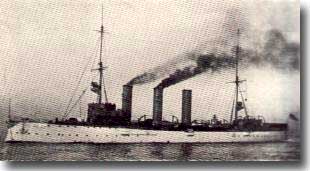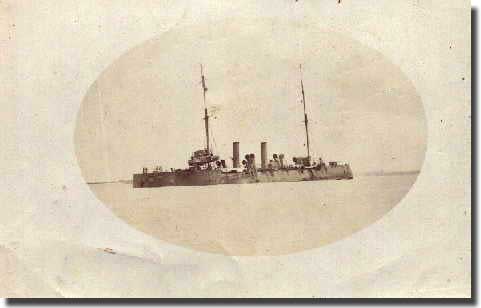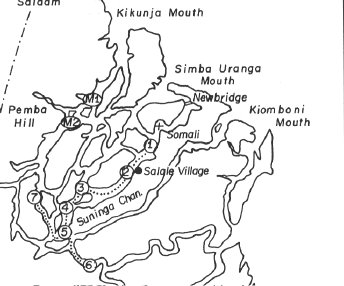Introduction.
Pre WW1, in what is today Tanzania, Germany possessed the colony of German East Africa, with Dar-es-Salaam as its capital. In 1913, the light cruiser SMS Konigsberg ( SMS stands for Seiner Majestat Schiff ie. His Majesty's Ship ) was sailed to this area reinforcing Germany's ability in time of war to wage commerce raiding with this ship. No doubt Great Britain was well aware of the proximity of this German colony to many of the major shipping routes of the Indian Ocean.

German Light Cruiser Konigsberg in WW1
German cruiser leaves from Kiel for East Africa.
With Captain Max Looff in command, SMS Konigsberg sailed out of Kiel on the 25th. of April in 1914, she passed through the Mediterranean, passaged the Suez canal, stopping at Aden, where her Captain even dined there with the British Governor, all very civil in time of peace, but even the , war clouds were looming on the horizon.
The cruiser made it to Matzetumbe, outside the port of Dar-es-Salaam by the 6th. of June 1914. What a contrast it was in East Africa compared to home in Kiel, the cold foggy coast of the North Sea a whole world away, here the dusty red earth pounded by a relentless sun, the dusky native people swarming over the local dock area.
Austrian Archduke assassinated.
The Austrian Archduke Ferdinand was assassinated in Serbia on the 29th. of June, and Europe was sliding down the slippery slope to war.
Captain Looff prepares his ship for service in the Indian Ocean.
Captain Looff prepared his ship for forthcoming events by training his crew with both gunnery and torpedo exercises at sea, all wooden furniture was landed, and the ship fully supplied. Coal supplies were laid in at Dar-es-Salaam, and the 2,500 ton Somali was assigned as the cruiser's supply ship. Intelligence was received, that three British cruisers were due to call at Zanzibar on the 1st. of August to coal their ships. If Konigsberg was not to be trapped in harbour, she needed to sail quickly, and the last day of July found the cruiser putting to sea, soon after, to be 10 miles off shore, when the masthead lookout reported to the bridge he had sighted three ships.
British Cruisers in sight.
This sighting turned into the three British cruisers:- Hyacinth, Pegasus, and Astria, they all soon formed up around the German ship, should war be declared, as expected, then Konigsberg would be in deep trouble. Captain Looff ordered steam for 22 knots, and prepared to wait it out, a sudden squall, bringing with it driving rain, changed the equation, he gained a reprieve, this bad weather hiding him from the British ships.
Konigsberg made a fast 180 degree turn, steaming towards the British cruisers, passing Hyacinth, and then turning south for an hour, working up to full speed, and heading out to sea for the rest of the night, but in the process, burning up much precious coal.
British Rear Admiral King-Hall absolutely livid, quite beside himself, at his forces allowing the German ship to elude them, escaping from their clutches.

British Cruiser HMS Pegasus, sunk by German Cruiser SMS Konigsberg.
World War 1 is declared.
It was but another six days before Captain Looff received the code word EGIMA, meaning his country was at war with England, now Konigsberg became the hunter.
First Blood.
On the 6th. of August 1914, the British SS City of Winchester was in the Gulf of Aden, making her way to London, She was crammed full of general cargo, including the 1st. of India's seasonal tea crop. Her Captain, George Boyak, now found his ship in company with a cruiser, which he thought was British, searchlights lit up his command, and he was asked by signal lamp " What ship and nationality?" He dutifully responded with the ship's name and port of registry, but was then ordered to stop.
The arrival on board of a German Naval Officer with his boarding party made the Captain suddenly realise his ship was now part of history, the first British ship to be captured by Germany in WW1, and the first victim of the Raider Konigsberg.
The problem of a coal supply for the Raider.
The coal position in Konigsberg was becoming critical, and she made off to rendezous with her supply ship Somali, tagging along with a prize crew onboard was the City of Winchester, plus the German freighters, Ziefen, Goldenfils, and Ostmark. All five ships anchored off the Island of Hallaniya, situated off the coast of Oman, 400 tons of cargo was transferred from the City of Winchester, and she was then scuttled.
This ship to go missing would soon ring the British alarm bells, and the German cruiser moved off independently for the East-West shipping lanes, but the cupboard was indeed bare.
Searching for Allied shipping.
Konigsberg needed more coal and fresh water, a second meeting with Somali was made, and by the 24th. of August the cruiser was on the prowl again. The ship made its way down the African coast towards Madagasgar, and then entered the Bay of Majunga on the morning of the 29th. of August, nothing there, the area absolutely empty of any shipping. The locals thought that their visitor was a British cruiser, but when it did not anchor, the local radio station reported that a German ship was around.
Coal is again running low.
Coal and its continued availability was a constant gnawing problem, the ship now down to one quarter of its bunkering capacity, and Konigsberg once more met up with Somali, but heavy seas precluded any attempt to recoal.
Throughout WW1, the supply of coal to the German Raiders roaming the seven seas in search of Allied shipping remained a real headache, and often the Raiders needed to rely upon their victims to supply much wanted coal. If a ship was stopped and her cargo happened to be a full load of quality steaming coal, it was indeed a bonus. It is interesting that in the Second World War, exactly the same problems with keeping up a supply of fuel for the German Armed Merchant Raiders still obtained. The coordination of having a Tanker and supply ship at the right place and time to meet a Raider in a vast ocean was always a difficult task.
The Rufiji River Delta.
It was now decided that both ships would make for the Rufiji River, and on the afternoon of the 3rd. of September 1914, they slipped over the bar at the mouth of the Rufiji River and steamed up the Simba Uranga Channel. Off went a message to Dar-es-Salaam to order both coal and supplies, local news reported a British Cruiser at Zanzibar, and Looff thought it was probably Pegasus or Astrea, it was the former, in port with boiler problems.

Map showing Konigberg's movements in the Rifiji River Delta.
The circled numbers are the German cruiser's anchorages,
M1 and M2 the position of the British Monitors for their final attack.
Captain Looff decides to destroy the British Cruiser.
The afternoon tide of the 19th. of September carried Konigsberg out to sea, and she set a course for Zanzibar. The following morning she destroyed the Channel Pilot Boat off the harbour entrance, and Pegasus came within range at 9,000 yards, and the German ship opened fire. Within 20 minutes the British cruiser was down by her bows and giving off heavy smoke. Looff made good his escape heading back out to sea, and a broken piston rod crosshead in one of the ship's main engines forced her Captain to return to the Rufiji Delta, where, together with Somali she was camouflaged, if a quick escape became necessary, there were several navigable channels that might be used.
The British react.
Two days after Konigsberg had sunk Pegasus, the German cruiser Emden ( a sister ship to Konigsberg ) had boldly steamed into the harbour of British Madras and bombarded it. The British had now had enough, and the 5,400 ton Royal Navy cruisers Chatham, Weymouth, and Dartmouth, were all sent out on a find and destroy mission seeking out Konigsberg.
When Chatham stopped and searched the German ship Prasident, she found orders to ship coal out to the Rufiji Delta, then on the afternoon of the 20th. of October a landing party from the British cruiser was combing this Delta area. A sailor shinned up a tree, and was able to detect the disguised masts of both Konigsberg and Somali poking up through the forest canopy. Chatham promptly called up her sister ships, and the blockade began.
The attack begins.
On the 2nd. of November the three British ships commenced their bombardment, but Looff promptly moved his two ships 2 miles further upstream. A few days later, Somali was hit by Chatham's gunfire, set alight, to soon become a total loss, one down and one to go! On the 9th. a British freighter Newbridge was sunk as a block ship in the mouth of the Ssuninga channel, but really to no effect, as Konigsberg never was able to obtain enough coal for her to make a dash for the open sea.
A long impasse.
A stalemate period of some eight months now ensued, the German ship could not escape, nor could the British cruisers get close enough to effectively bombard her. A fortified zone was created around the Delta by German forces, and no British push could penetrate it. British aircraft tried spotting the fall of shot, but Captain Looff set up an Anti-Aircraft defence which shot down one of them, and his move proved effective.
The Blockade Runner Ruebens.
By April 1915, the Germans were desperate to break out Konigsberg, a supply ship Ruebens carrying 1,600 tons of coal for the cruiser, plus a host of ammunition and much needed supplies arrived in the Indian Ocean. The ship disguised as a Danish freighter was known to the British authorities, and when she arrived at Manza Bay, the British cruiser Hyacinth came up from the South at full speed, Rueben's Captain was so panic stricken, he ran his ship aground, evacuated his crew, and torched his ship.
He was unaware that Hycanith then broke down, with only half speed available to her, but she shelled Ruebens, and her timid Captain scuttled her. When the British returned to the scene some weeks later, the Germans had salvaged all the cargo except the coal.
Konigsberg was stranded.
With the loss of Ruebens, Konigsberg was now stranded high and dry. The British went about very systematrically charting all of the cruiser's defences, and two shallow draft River Monitors, Severn and Mersey were sent off on their way to the Delta where they finally arrived in June of 1915.

HMS Severn, one of the two British shallow draft River Monitors
used against the German light cruiser Konigsberg.
The end is nigh for Konigsberg.
The British plan which they had worked toward for months was now implemented. The Monitoirs headed up the Kikunja arm of the River Delta, opposed only by sporadic small arms fire. As they closed in, two British operational aircraft dropped bombs close to the German ship to act as a diversion.
At 0645 ( 6.45 AM ) the Monitors opened fire at a range of 10,000 yards, and soon after the German cruiser responded with return fire, and by 0740 ( 7.40 AM ) she had gained two hits on Mersey who was forced to retire, leaving Severn to continue the assault, she opened the range another 1,000 yards. Although the rather incredible number of British rounds fired added up to 635 from their 6 inch guns, only 3 of them actually struck Konigsberg.
Four days of peace.
Now four days of quietness descended on the scene, but early on Sunday morning of the 11th. of July, British aircraft circled Konigsberg, to announce a renewal of the action.
By 1115 ( 11.15 AM ) the Monitors had entered the River, and within 30 minutes the German ship opened fire with four guns of her main armament, but she could not match the rate of fire from the Monitors who began to score hits along her entire length. In addition, the German was short of ammunition, her middle funnel was brought down, smoke poured from her hollow mast, a fire started close to the forward magazine, by 1300 ( 1. PM ) Konigsberg was lost.
Abandon Ship was ordered, and the crew scrambled down the ship's side, taking their wounded with them. Shells from the Monitors continued to pour into the stricken German cruiser. First Officer Koch placed torpedo heads in position to blow out the ship's keel, and at 1400 ( 2 PM ) on the 11th. of July 1915, these heads detonated, SMS Konigsberg heaved slightly, then with a roar, the hull blasted apart, she heeled over to port, and sank into the ooze of the Rifiji River.
An hour later the British Monitors retired, well satisfied, and victorious at last.
Konigsberg armament salvaged.
The Germans quickly salvaged the ten main armament guns from their stricken cruiser, to use them in the East African land campaign. In Dar-es-Salaam workshops, gun carriages were fashioned to carry these Naval guns, now formed into land artillery.
Fate of the crew from Konigsberg.
From the original crew of 350 Officers and Sailors, only Captain Max Loof and 14 others survived WW1, to eventually return home to Germany.
Conclusion.
This rather bizarre chapter in the early part of WW1, stage in the more remote region of German East Africa, proved that a resourceful Captain Looff, and his crew could tie up more formidable enemy forces for many months before sheer numbers overcame his resistance. An intriguing story from a now distant past.
By a strange twist of fate, two 4 inch guns from Konigsberg have survived today, one is in Mombasa, and the second in Pretoria. The Mombasa gun sits close to one salvaged from the British Cruiser Pegasus, in WW1 each ship fought against each other at Zanzibar, now the two guns peacefully coexist side by side.




